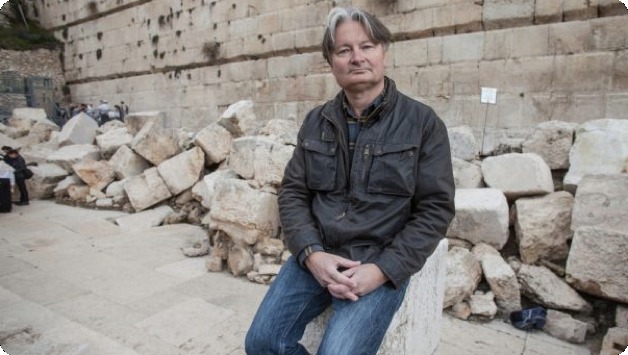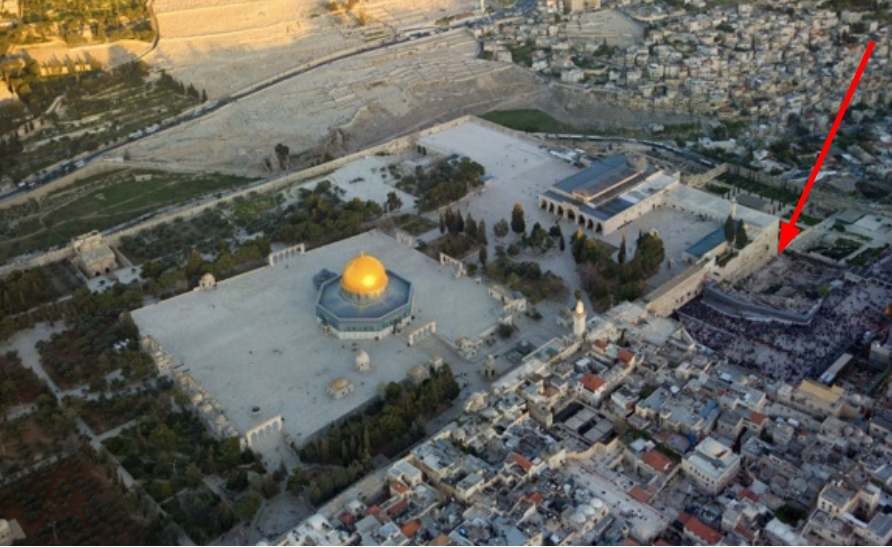
Those stones that so many Christians and Jews point to as the sacred remnants of Herod’s Temple destroyed in 70 CE may really be the refuse of an earthquake that hit Jerusalem in 363 CE.
Since the uncovering of these fallen stones in the 1970s the consensus has been that they are definitely the signs of the Roman destruction of Jerusalem.
“Not one stone shall be left upon another,” goes the prophecy of Jesus, and there is the evidence. Jews see them as the tangible link to the moment when they were believed to have been exiled from their city.
The January 4th 2015 edition of Haaretz publishes a challenge to all of that:
Main points of Professor Gibson’s thesis that was presented at Bar-Ilan University. I summarize them here:
1. How could they leave debris in the middle of a rebuilt city?
Since the discovery of these stones in the 1970s archaeologists have learned much more about Roman Jerusalem after that fateful year 70 CE.
Recent archaeological digs taught us that Roman Jerusalem (which became known as Aelia Capitolina) was a functioning city with a rich population, sturdy homes, a commercial life and wide, elegant streets.
It makes no sense to think that such a thriving city would leave the rubble from the year 70 lying in in its civic heart. Jerusalem was rebuilt. Stones from the previous destruction are the most likely to be the first to be used in that rebuilding.
2. Why would anyone build a bakery business beside a damaged wall and fallen stones?
A Roman era bakery has been discovered next to the rubble.
You don’t build next to a four-storey ruin.
3. The anachronism of the Temple Mount pillars
The pillars associated with the Temple Mount demonstrate the same artisanship as found at the Church of the Holy Sepulchre, the Tomb of the Patriarchs and Mamre. At these three sites are found religious structures built centuries after 70 CE.
According to Gibson, the builders of these structures, at the beginning of the fourth century C.E., saw the Temple Mount walls and tried to imitate them, as part of the effort of Christianity at that time to prove that it was the successor of Judaism.
If the walls were destroyed in 70 C.E., asserts Gibson, how could the builders of 325 C.E. succeed in copying them. . . . He concludes that the walls still stood hundreds of years after the destruction, and served as inspiration for the Roman builders.
Furthermore, why would a Roman legion bother to destroy the walls in an “expensive and complex engineering operation” after the Temple was already in ruins?
4. The great earthquake of 363 CE
Emperor Julian the Apostate had encouraged pagan worship throughout the empire to counter the influence of Christianity and also permitted the Jews to return and rebuild their temple. The earthquake put a stop to their efforts. This massive earthquake is well documented in the Christian literature.
“Half of Jerusalem was destroyed during this earthquake,” says Gibson. “I suggest that the Temple Mount walls fell at the same time. The way the stones lie is also more consistent with an earthquake than destruction by man. I propose that perhaps the debris we see there are also from the destruction of 363 C.E.”
Opposing Argument
Prof. Ronny Reich, who was a partner in the original Southern Wall digs in the 1970s and ran the excavations in the ’90s together with Prof. Yaakov Billig, vehemently rejects Gibson’s theories.
Reich points out that the rubble does not lie on a street but on a layer of sediment up to five centimetres thick. The original excavators in the 1970s cleaned that layer carefully and found around 120 coins, the last one dated 69 CE.
Reich believes that this sediment accumulated on a road that had become disused after the 70 CE destruction. The Romans did not destroy the wall at that time but some time afterwards, perhaps in honour of a visit by Emperor Hadrian in 130 CE.
Reich also suggests that the walls of the Temple Mount were not just another flimsy structure that would easily collapse in an earthquake.
And Reply
Gibson claims that there are several ways the coins could have rolled underneath the rubble:
- builders wanting to level the road in a later period might have brought dirt from elsewhere; or
- the stones may have been moved and rearranged to be employed for secondary use.
Sometimes in archaeology, [Gibson] says, there are ideas that need to be raised to rethink things. “We all accepted as gospel that these stones fell in the year 70, and I don’t want to remove from anyone the symbolism of these stones. But I have an interest in the historic, substantive side,” he says. “I tried to convince myself that I am wrong because the heart wants it to be the year 70, but it goes against reason. The goal is that people start to think about it – and if I am wrong, then I am wrong. Life will go on.”
H/T Archeologia Biblica e Storia della Chiesa di Antonio Lombatti and TaborBlog.

If you enjoyed this post, please consider donating to Vridar. Thanks!


Interestingly, Julian the apostate had planned to re-build the temple in 363 as a way to disprove “Jesus’ prophecy” in order to try and combat Christianity among the Roman army and elites. But the project was apparently sabotaged by Christians and never completed.
http://www.fisheaters.com/juliantemple.html
But this also means that the temple was definitely destroyed by the time Julian came along. This also speaks to the fact that the significance of prophecy and the temple was very much a major issue at the time.
You are mentioned at Hurtado’s New School lecture:
Do I want to know more? Link?
I saw him say something about readers commenting on his blog with the intent of finding fault only. Maybe he was thinking of me as one of those. I don’t think he could ever grasp the idea that a layman would really genuinely try to engage him in a discussion about his assumptions and methods. That’s “fault-finding” in his eyes, I suspect.
I could never understand why he took the stance he did with me in our exchanges, both online and by email. I had to conclude that he was informed about me by other third parties who had poisoned his ability to read anything I wrote.
Ah, I found it. He mentions me in between scoffing at another commentator who has left many posts on Vridar, too, and who does not appear to me to be fully sane. My first name only is used. Starts at 4:10. I think everyone is supposed to be amused and impressed at Larry’s “witty” dismissal of my attempt to engage him with some questions. http://www.youtube.com/watch?v=ddaIFFNjsOI